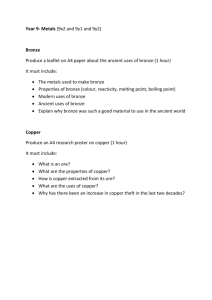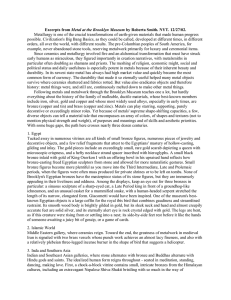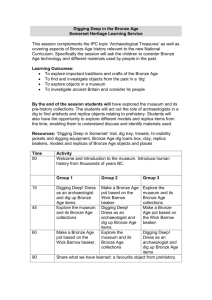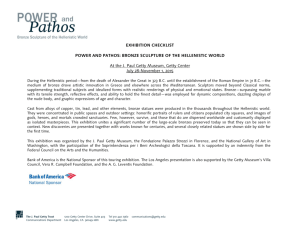- British Museum
advertisement
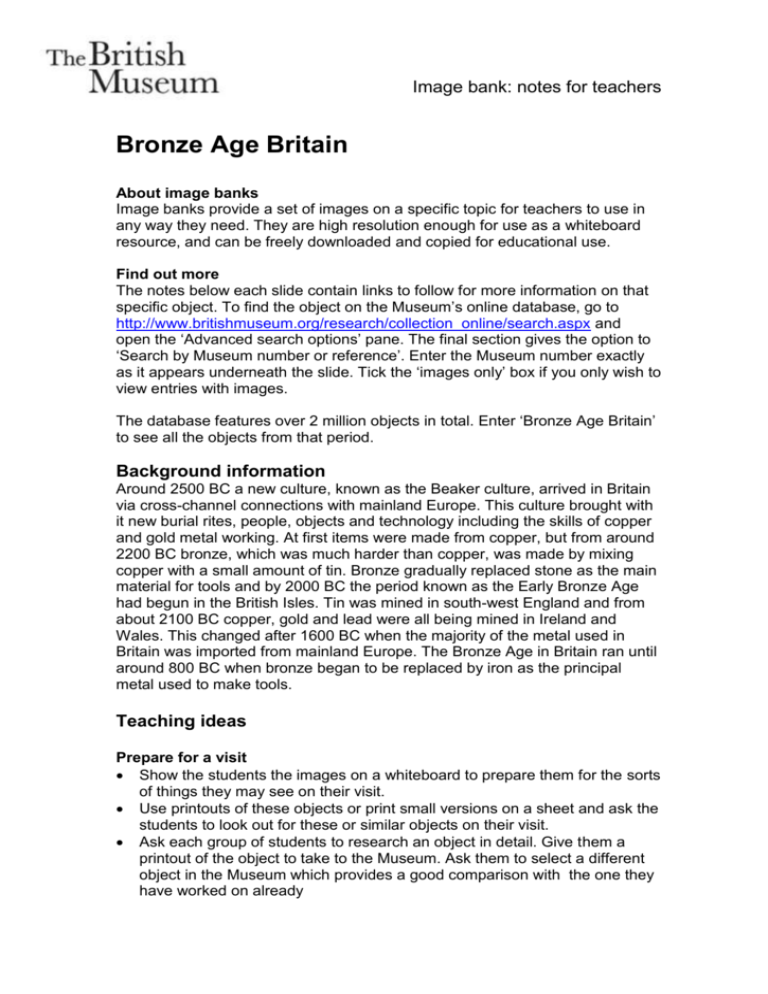
Image bank: notes for teachers Bronze Age Britain About image banks Image banks provide a set of images on a specific topic for teachers to use in any way they need. They are high resolution enough for use as a whiteboard resource, and can be freely downloaded and copied for educational use. Find out more The notes below each slide contain links to follow for more information on that specific object. To find the object on the Museum’s online database, go to http://www.britishmuseum.org/research/collection_online/search.aspx and open the ‘Advanced search options’ pane. The final section gives the option to ‘Search by Museum number or reference’. Enter the Museum number exactly as it appears underneath the slide. Tick the ‘images only’ box if you only wish to view entries with images. The database features over 2 million objects in total. Enter ‘Bronze Age Britain’ to see all the objects from that period. Background information Around 2500 BC a new culture, known as the Beaker culture, arrived in Britain via cross-channel connections with mainland Europe. This culture brought with it new burial rites, people, objects and technology including the skills of copper and gold metal working. At first items were made from copper, but from around 2200 BC bronze, which was much harder than copper, was made by mixing copper with a small amount of tin. Bronze gradually replaced stone as the main material for tools and by 2000 BC the period known as the Early Bronze Age had begun in the British Isles. Tin was mined in south-west England and from about 2100 BC copper, gold and lead were all being mined in Ireland and Wales. This changed after 1600 BC when the majority of the metal used in Britain was imported from mainland Europe. The Bronze Age in Britain ran until around 800 BC when bronze began to be replaced by iron as the principal metal used to make tools. Teaching ideas Prepare for a visit Show the students the images on a whiteboard to prepare them for the sorts of things they may see on their visit. Use printouts of these objects or print small versions on a sheet and ask the students to look out for these or similar objects on their visit. Ask each group of students to research an object in detail. Give them a printout of the object to take to the Museum. Ask them to select a different object in the Museum which provides a good comparison with the one they have worked on already Image bank: notes for teachers Talk about the images Introduce vocabulary associated with the objects such as materials (e.g. silver, stone, pottery), technical terms (e.g. constructed, carved, cast), name of object (e.g. statuette, hoard, tombstone), function of object (e.g. conflict, eating and drinking, religious expression). Investigate the images as source material Discuss archaeological evidence in general. What sorts of factors determine whether an object survives? Print out the objects and distribute around groups. Ask students to consider why these objects have survived. Compare other archaeological evidence for the period. Provide students with samples of the real materials used to make the objects. Use these to investigate properties, such as weight, flexibility, floating/sinking, magnetism. Print out all the images on to card, chop them up into pieces and then rebuild as jigsaws. Use as a starting point to talk about archaeology and reconstructing objects from the past. Interrogate the images Use Visual Thinking Strategies to engage your students when looking at one of the images in depth, eg What’s going on in this picture? What do you see that makes you say that? For more information: www.vtshome.org Use Thinking Routines such as “I see / I think / I wonder” or “colours, shapes, lines” which are very well suited to exploring and appreciating images, as well as helping the students to improve their critical thinking skills. For more information: www.pzartfulthinking.org/routines.php Who would have been involved with the life of this object from the raw material being obtained, through its manufacture, decoration, sale, purchase, use, breakage, loss, excavation, rediscovery to its exhibition in a museum? Storyboard the life of the object from its origins to its current location/display. Print an image and use it as the centre of a mind map. Work in pairs where one person describes the image and the other draws what they hear. Classify the images Ask the students to imagine that they are organizing the objects in a display cabinet for people to look at. Ask them to research the objects to find out how large they are (or you could supply this information) and then ask them to design a cabinet (deciding how many shelves to have and how big to make the cabinet) and then arrange the objects appropriate to their size and shape. Print out the objects. Research the date of each object and use them to make an object timeline or group them according to date. Use a website such as Pinterest (or just use Word) to create a pinboard of your favourite objects from the image bank. Research these and write captions. Now add other objects from outside the Museum, and any relevant or interesting facts. For an example see http://pinterest.com/carolynhowitt/tudors/ Image bank: notes for teachers Compare the images Think how different cultures interpret the same object. Gold for Pre-hispanic Colombians and gold for the Europeans. Money would be another examplefeathers/shells etc. Compare the objects with modern examples of the same kind, e.g. a coin, a letter, a pot. What are the similarities and the differences? What aspects of continuity and change can you observe? What do we use today for the same purpose? Compare and contrast the past and present to think about the future. Look at an object and write a label for it. Investigate the same object and write a label for it. Compare the content of each label from descriptive text to evaluative text. Use the images to fire creativity and imagination Create a fictional narrative between objects/designs/characters on objects to develop creative thought and team work. Select or create a piece of music or other performance that links to the feeling of the object or uses the characters/culture that you are looking at. Use the objects as a source of inspiration for art and design work on function (e.g. a container), geometric patterns, shapes or colour. Further reading For students Prehistoric Britain (British Museum Activity Books) by Mike Corbishley (British Museum Press, 1999) Online information Find out about Bronze Age finds from your local area using the Portable Antiquities Scheme PAS database at www.finds.org.uk.




